
Which trends offer opportunities or pose threats on the European outbound tourism market?
Sustainability is the biggest trend in tourism today. It is vital to support the global commitment to reach net zero by 2050. Transformational and sustainable travel is a key part of this. It focuses on personal growth and self-discovery through authentic, immersive and sustainable experiences. Other key trends in the tourism industry today include digitalisation to increase efficiency and sustainability, understanding the importance of Gen Y, Gen Z and the solo travel market, and meeting accessibility needs.
Contents of this page
- Primary trend: tourism sector transformation and sustainability
- The new way to travel – transformational and experiential travel
- Harnessing digitalisation and AI for growth
- Solo travel is a key trend
- Gen Y and Gen Z shaping the future of travel
- Embracing accessibility and the ageing market
- Trend for more robust safety and security measures
1. Primary trend: tourism sector transformation and sustainability
Sustainability in business practices is transforming every industry sector. Tourism contributes a lot to harmful carbon emissions. Implementing sustainability throughout the global tourism industry is urgent and essential, in line with global travellers’ desires to live and travel more sustainably. Studies show that 83% of travellers consider sustainable travel to be important. Becoming certified as a sustainable business is an important part of this transformation.
Sustainability in tourism
Sustainable development in tourism is defined by the United Nations World Tourism Organisation (UNWTO) as “tourism that takes full account of its current and future economic, social and environment impacts, addressing the needs of visitors, the industry, the environment and host communities.”
Transitioning to a sustainable business is no longer just a trend. It has become urgent and essential to tackle the climate crisis and reduce carbon emissions. Tourism is a major contributor to climate change, and the sector is forecast to grow at an average of 5.8% a year until 2032. This is significantly less than the expected growth of the global economy of 3.2% a year. In the meantime, the global commitment across all sectors is to halve emissions by 2030 and reach net zero by 2050.
A range of acts have been implemented, including the Glasgow Declaration on Climate Action in Tourism, the Carbon Offsetting and Reduction Scheme for International Aviation (CORSIA) and the Call to Action for Decarbonisation of Shipping, which is supported by the Cruise Lines International Association (CLIA). Many European tour operators, like Intrepid and Better Places, are B Corp certified and have joined forces to act on the climate emergency through the B Corp Climate Collective.
At the destination level, France was the first country to ban short haul flights in an effort to reduce carbon emissions in 2022. This regulation banned flights if there was a rail alternative that took less than two and a half hours. Spain was the second European country to consider a similar ban in 2024.
Electric ferries are set to become the next revolution in electric-powered transport options. It is estimated that half of the continent’s ferries will need replacing over the next decade. Scandinavia leads the way in e-ferry development. Currently, Norway has about 80 electric ferries, including the world’s largest all-electric car and passenger ferry. By 2026, only zero-emission vessels will be allowed to sail in the fjords in western Norway. Electric ferries are now more common throughout Europe. Electric ferries were also used to transport athletes down the River Seine during the Paris Olympics in 2024.
Figure 1: There is no Planet B
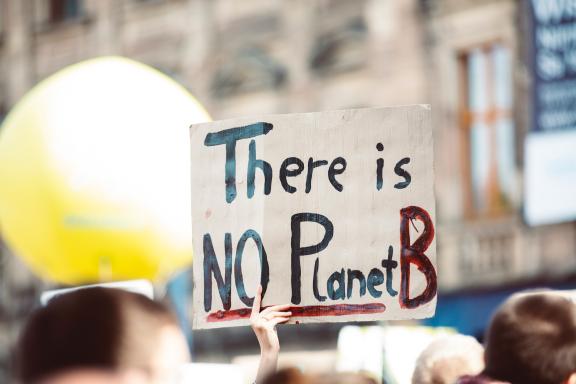
Source: Markus Spiske on Unsplash
Overtourism
The negative impacts of overtourism are now better known. There are many examples of destinations that suffer from overtourism, including famous places like Machu Picchu and the Galapagos Islands, and iconic cities like Dubrovnik and Venice. Residents in places like Mallorca, Barcelona and the Canary Islands have openly expressed their frustration with mass tourism. Environmental degradation, water shortages, waste management, rising house prices, noise pollution and erosion of the local culture are just a few issues that cause problems.
It is essential destinations, businesses and travellers themselves put practical measures in place to combat overtourism. Here are some of the practical steps that destinations have taken.
- Visitors to Machu Picchu are now strictly controlled. Daily visitor capacity to Machu Picchu has been reduced to 5,000 per day.
- Land-based visitors to the Galapagos Islands are now charged an entry fee of $200 (USD), a rise from $100, the first increase since 1998.
- In 2022, the Kingdom of Bhutan introduced a Sustainable Development Fee of $200 (USD) per night per tourist. However, this was dropped to $100 per night in 2023 to encourage longer stays.
- Tourist taxes are quite common, but new taxes to mitigate against overtourism have been introduced. Venice charges day tourists €5 per day and overnight visitors between €1 and €5 per night. A tourist tax of around €8 was introduced in Bali in 2024.
- New Zealand tripled its tourist tax in October 2024 from $35 (NZD) to $100. Find out more about destinations charging tourist tax in this article: Tourist tax: these are the destinations you’ll have to pay to enter.
- In 2024, Japan erected a barrier to block the view to prevent tourists from crowding in front of a grocery store to capture images of Mount Fuji. Summer hikers were charged for climbing Mount Fuji, and numbers were capped. In Kyoto, visitors were banned from the city’s geisha district.
- Venice banned ships from the Grand Canal in 2021. Barcelona is looking to reduce the numbers of passengers that disembark. Amsterdam, Santorini and Dubrovnik have all increased restrictions on cruise companies.
- No new hotels can be constructed in Amsterdam unless as a replacement in the city’s fight to ban mass tourism and to cap visitor numbers at 20 million hotel overnight stays per year.
- Other popular and sustainable strategies to combat overtourism include encouraging out-of-season travel, promoting lesser-visited destinations, community-based tourism and ecotourism.
Consumer demand for sustainable travel options
Travelling sustainably is still at the forefront of people’s minds. This is despite economic uncertainties and high cost of living affecting people all over the world. The climate crisis has encouraged people to make more sustainable travel choices. Booking.com’s 2024 Sustainable Travel Report found that:
- 75% of global travellers say they want to travel more sustainably over the next 12 months
- 57% intend to reduce their energy consumption on future trips
- 54% intend to use more sustainable modes of transport when travelling in the future
- 43% feel guilty when they make less sustainable travel choices
It is clear that travellers understand the benefits of travelling sustainably. Of those who want to travel sustainably:
- 32% want to do so because they believe it is the right thing to do
- 16% believe travelling more sustainably will enhance their experience
- 11% believe they would have a more authentic experience of the local culture
- 7% want to do so because it will make their trip more fun
Regenerative tourism takes sustainability one step further. Although they are closely linked, regenerative tourism aims to make things better than they were before. Booking.com found that 71% of people wanted to leave the places they visited better than when they first came, and 69% wanted the money they spent when travelling to go back to the local community. These findings prove there is a market of tourists committed to sustainable travel where it is readily available.
Be aware of the ‘say-do’ gap
Although Europeans are eco-conscious, it is clear that, while around half of tourists say they want to make sustainable travel choices, less than 10% actually do so. This is known as the ‘say-do gap’. Addressing this gap will be key for the tourism industry in the coming years.
Table 2: What people say versus what people do

Source: Phocuswright, 2023
The say-do gap exists for many reasons but cost and convenience are key factors. People also say they suffer from ‘compassion fatigue’; more than 30% of people say they are tired of the continuous messages about climate change. Watch this video by Phocuswright Research, The Sustainability Gap – Belief vs Behaviour. It shows very clearly that what people say is not the same as what they do.
However, in the case of overtourism, which has an obvious, physical and negative effect on the travel experience, there is evidence that the say-do gap is narrower, as people deliberately choose less popular destinations. This is good news, but long term sustainability is reliant on tourism providers developing products that do not encourage overtourism.
To help close the gap, tourism providers need to incentivise their customers to make sustainable choices in the future. Tour operators must make it easy for consumers to make sustainable choices and provide relevant information. Making your business fully sustainable is one way to do this.
Get certified as a sustainable tourism business
European tour operators and other tourism service providers need to put sustainable practices in place into their businesses under the European Green Deal. This is necessary to achieve net zero carbon emissions by 2050. Some European buyers will only work with businesses that are certified as sustainable. This will help you if you can become a certified business.
There are lots of certification schemes. Many conform to the Global Sustainable Tourism Council (GSTC) criteria, which are recognised internationally. Travelife for Tour Operators is a GSTC-recognised scheme that is particularly visible in Europe. The Good Travel Seal provides a more affordable scheme for SMEs. TourCert has schemes for tour operators as well as accommodation providers.
It is important that you manage your business sustainably even if you cannot afford to apply for certification. However, you must monitor your actions and be able to prove your claims to your buyers. They will not accept any greenwashing or false claims. This way, once you can afford it, you will already be well on the way towards doing what will be required.
Understand the benefits of certification
- Increased sales. European buyers are more likely to want to do business with you if you are certified. One study found that 66% of global consumers are prepared to pay more for products and services from companies committed to social and environmental responsibility.
- Improved reputation. European buyers will be assured that your claims are true. Official certification adds credibility to your sustainability claims. It reassures tourists that you care about the environment and local communities and are not greenwashing.
- Reduced costs. Operating your business sustainably can lead to savings in terms of energy, water use and waste.
- Increased employee satisfaction. Employees are more likely to be engaged and productive if you and your team have a shared purpose, commitment and work together to make a meaningful contribution.
To help you understand what greenwashing is and how to avoid it, read up on the new EU directive: the Green Claims Directive. It will help you to be extra clear and careful when you are describing your sustainability actions. The Good Tourism Institute has a free e-book you can download to help you understand the Green Claims Directive.
What does this mean for SMEs?
For SMEs, maximising the benefits of responsible tourism and minimising harmful impacts is key to sustainable and regenerative tourism. Clarity about sustainable actions and the benefits to local people and the environment are key to effective marketing, management and the long-term sustainability of tourism products.
There are many examples of successful sustainable and regenerative tourism programmes on the market today that can serve as case studies. Take a look at these initiatives to see how your business measures up.
- Mdumbi Backpackers: a sustainable hostel in South Africa
- Prainha do Canto Verde: a community of artisan fishermen offering community-based tourism experiences in Brazil
- Ecotourism in Arenas del Mar, Costa Rica
- Long-term conservation at Singita Kwitonda Lodge, Rwanda
- Global Himalayan Expedition, India: clean energy impact expeditions to support remote Himalayan communities
- KARA-TUNGA Tours, Uganda: a social enterprise. All tours benefit and involve local communities
Looking ahead: transformation to a sustainable market
Sustainable tourism is anticipated to be expected and normal by 2030. You can expect other transformations too, such as:
- Sustainable travel options like electric vehicles and train travel will be more affordable and readily available.
- Most tourism experiences will be clearly marketed as sustainable, and there will be measurable benefits to local communities and places.
- Technology and biofuels will transform the air and cruise sectors.
- Sustainability will be embedded throughout the hospitality industry, including in accommodation and food and drink establishments. Options like ecolodges and community homestays will be highly sought after.
- Tourists themselves will have a positive effect on destinations through their choices. Community-based tourism, volunteering, enjoying authentic slow travel, staying locally and for longer, and participating in meaningful interactions with local people and places will be popular options for eco-conscious tourists.
Tips:
- Research to find out how tourism businesses in your area have embedded sustainability. This way, you can assess your actions and improve where required.
- Investigate sustainability certification schemes that suit your business the best. Consult the CBI study How to be a sustainable tourism business to learn how to embed sustainability into your business and to find out about available sustainability certification schemes.
2. The new way to travel – transformational and experiential travel
Transformational travel is a key trend that has been growing since the end of the COVID-19 pandemic. It focuses on personal growth, self-discovery and transformation. It is about having experiences that are personally fulfilling. Transformational travel encompasses a wide range of concepts, including meaningful travel, regenerative travel, volunteering, cultural exchanges, learning a new skill and doing work placements.
Transformational travel also involves experiential travel. This is travelling to immerse oneself in a place and having an authentic experience, rather than just visiting somewhere and looking in. It is also about sustainable travel, making strong and positive connections with local people and places.
This type of travel is one of the fastest growing niche markets. It is driven by the growing demand for unique, authentic and transformative experiences. A recent study showed that 79% of Millennials and Gen Z believe the quality of an experience is more important than price. Ever more travellers want to escape mass tourism’s commercialism, exploitation of local resources and communities and lack of personalisation. The increased interest in sustainability and responsible tourism has also contributed to this sector’s growth.
Trending niches in transformational travel
These are some of the most interesting niche market trends linked to transformational and experiential travel that are set to shape the future tourism demand.
Indigenous-led community-based tourism
Indigenous groups all over the world actively promote tourism in their areas. As part of the community-based tourism niche (CBT), indigenous tourism is in high demand from travellers keen to learn about indigenous ways of living and who want to make positive contributions to people and communities who have faced severe hardships for generations. There are some good examples of indigenous groups that have harnessed tourism to provide employment and generate economic self-sufficiency.
The Tomarapi Ecotourist Lodge in Oruro, Bolivia is a community enterprise managed by local Aymara families. They offer guided hiking tours as well as accommodation. Ol Lentille in Kenya is a good example of sustainable tourism, community partnership and world class architecture. The partnership has created, conserved and protected more than 40,000 acres of wilderness.
Agritourism a rising trend in experiential tourism
In line with slow, adventure, nature and ecotourism, there is growing interest in agritourism. This focuses on activities that relate to farming like visiting farms, vineyards, orchards and food production facilities. Agritourism is popular amongst people who want to connect with rural culture and farming traditions. Agritourism is guided by sustainable principles as demonstrated by the Belmont Estate in Grenada, which practises organic regenerative farming to maximise the health of the soil, restore ecosystems and enhance biodiversity.
As the importance of rural tourism grows, so too do the creation of new jobs to protect livelihoods, the promotion of cultural heritage and the protection of the environment as key benefits to communities. Meeting challenges like infrastructure and access, lack of digitalisation and rural depopulation will be important in years to come.
Being small-scale, intimate, personal and authentic, agritourism provides opportunities for travellers to experience something unique and give back to the world.Find out more in the CBI study What are the opportunities in the European agritourism market.
Figure 2: Agritourism offers immersive experiences, such as wine tasting in Portugal
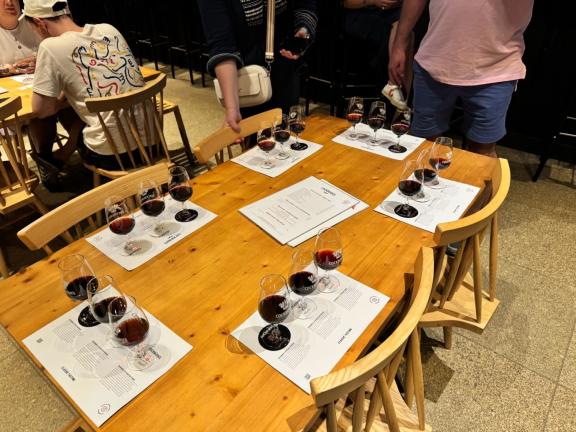
Source: Acorn Tourism Consulting, 2024
Wellness is the new luxury
Getting away from it all, ‘recharging batteries’ and focusing on physical and mental health are key requirements of wellness tourism. The wellness tourism sector has recovered after the COVID-19 pandemic, as it fits well with the desire to re-evaluate priorities and focus on personal wellbeing. Wellness tourism is extremely broad. It encompasses traditional wellness activities like yoga, spa treatments and wellness resorts. Today’s wellness tourists also take part in CBT, nature and ecotourism, cycling, swimming and walking, all in the quest for personal wellness and fitness.
There is also high demand for luxury. Luxury tourism is growing, and it crosses over with wellness and transformational travel. Luxury travel is no longer just about five-star hotels and luxury wellness resorts. Today, it is also about adventure and immersive experiences that are delivered to a very high standard. Across all consumer groups, tourists are increasingly prepared to pay for one-off luxury experiences that match their need for personal fulfilment and contribute to their personal wellness.
There are many good examples of luxury case studies in developing countries. The Clouds Mountain Gorilla Lodge in Uganda is a luxury safari lodge located in a remote area of the Bwindi Impenetrable Forest. Each cottage has its own private living room and wood burning fireplace. In Costa Rica, the Nayara Tented Camp boasts natural beauty, intimate spaces and connection with nature. Visitors stay in large tents inspired by African safaris, which have great views and low carbon footprints.
There is a growing need to hold luxury brands accountable for sustainability practices and recognise that sustainability can enhance their products. Balancing the high market expectations with eco-friendly practices and social impact requires creativity and financial commitment. There is an opportunity for providers in this niche to redefine luxury around principles of sustainability and to lead the way for environmentally and socially responsible actions.
To find out about these markets, read the CBI studies What are the opportunities on the European wellness tourism market and What are the opportunities on the European luxury tourism market.
Reducing carbon footprint drives interest in train trips
Consumers understand the need to reduce their personal carbon footprints. Although the say-do gap is a concern, there is evidence that many Europeans seek more carbon-friendly ways to travel, particularly by train. Destinations that can be reached be train are becoming more popular. Train travel can reduce personal carbon footprint by up to 90% compared with flying the same distance. The added great benefit of overland travel is how it makes travelling to the destination part of the adventure. This fits well with the trend for transformational travel.
Some scenic landscapes are best seen by train. Many tour operators include train trips in their itineraries, such as Original Travel. Great Rail Journeys sells train trips all over the world, while Byway specialises in flight-free travel using trains, bikes, busses and ferries.
Figure 3: Travelling by train is part of the adventure

Source: Jack Anstey on Unsplash
New train routes are being developed, such as the Tren Maya project on the Yucatán peninsula, which links coastal destinations with ancient Mayan sites. The luxury Eastern & Oriental Express rail experience in Malaysia was relaunched in 2024. In Switzerland, the new GoldenPass Express was launched between Interlaken and Montreux. It uses new technology that enables the train to travel over narrow and wide gauges – the width of the rail tracks. As gauges vary all over the world, technological innovation like this has the power to transform the global rail industry in years to come.
Looking ahead
Transformational travel is set to stay, and its impact on the provision of tourism will be significant. However, there is growing expectation that, to be really transformational, its benefits must be real and measurable. As a result, sustainability certification will become more common. Mass tourism, defined as many thousands of people going to the same place often at the same time of the year, will also continue. However, sustainability will play a key part in its delivery.
Industry experts expect that communities and local stakeholders will gain more control of decisions about their destinations and tourism. This is set to support greater understandings of destinations, their communities and visitors for transformational experiences.
Tips:
- Assess your trips for their immersive, authentic and transformative qualities. Make sure you use storytelling in your descriptions to inspire your guests. Storytelling is a powerful way to convey emotion and showcase unique experiences, culture and history. Use all forms of content – text, images and videos – to their best effect. Read this blog by Trekksoft, Unlocking the power of brand storytelling in the tourism industry, for inspiration.
- Include your sustainability credentials in your marketing. This is becoming ever more necessary. European buyers will not do business with you unless you can prove you are a sustainable business.
3. Harnessing digitalisation and AI for growth
Digitalisation is transforming how companies do business. It has lots of benefits for tourism businesses. It can harness creativity and innovation, increase efficiency, enhance visitor satisfaction, provide insights and boost sustainability. Digitalisation and AI (artificial intelligence) in tourism can touch on everything from the digitalisation of daily processes to using big data and blockchain, from managing websites and social media platforms to mobile connectivity, from online sales to content creation.
How AI is transforming the tourism sector
AI has been embraced by the tourism industry, and it has shaped how businesses, large and small, conduct operations. Large travel websites like Tripadvisor use AI to personalise search results. Revenue management systems and marketing tools use AI to provide streamlined processes and provide effective results.
Hotels are big users of AI. They use it to personalise experiences for their guests, operate chatbots and manage dynamic pricing. Some chains, like the Marriott, Hilton and InterContinental Hotels Group (IHG), use AI systems to optimise their energy usage, reduce costs and minimise their properties’ environmental impact. Spanish chain Iberostar uses AI-powered technology to help it become waste free by 2025 and carbon neutral by 2030. In the first six months of the scheme, which launched in 2023, the hotel chain saved 735,000 meals and saw an 11% reduction in waste weight.
Chatbots are one of the simplest and most cost-effective forms of AI. They can answer a range of queries easily and quickly, and they are widely used in the travel industry. According to Statista in 2020, 25% of travel and hospitality companies use chatbots to make enquiries or complete bookings; a further 46% plan on using them. Research found that 87% of customers would use a travel chatbot if it saved them time and money.
Generative AI, or GenAI, can generate text, images, videos and even music using generative models (large language models or LLMs). Open AI’s ChatGPT is the most famous. It grew from zero users to 100 million in just three months, faster than any other form of AI technology.
There are several other platforms, many of which offer free subscriptions. These include Google’s Gemini (rebranded from Bard in 2024), Claude AI and Microsoft’s Bing AI Chat. They can be useful business tools to create short-form content using original content. For instance, as a tour operator, you could ask these tools to suggest a catchy name for your tour or ask them to create a summary of information you provide it for your tour.
Other GenAI tools can generate images and professional designs, like Canva and DALL-E. Tools like Runway use GenAI to create high quality videos from text. There are also GenAI tools that can create music inspired by a few bars or a melody or text like Soundraw.
From a consumer perspective, travellers can use GenAI to find holiday inspiration. Research has found that one third of travellers would use ChatGPT to plan their holiday. There are also blogs and videos to help consumers get started with their travel planning.
Figure 4: Using GenAI for holiday inspiration
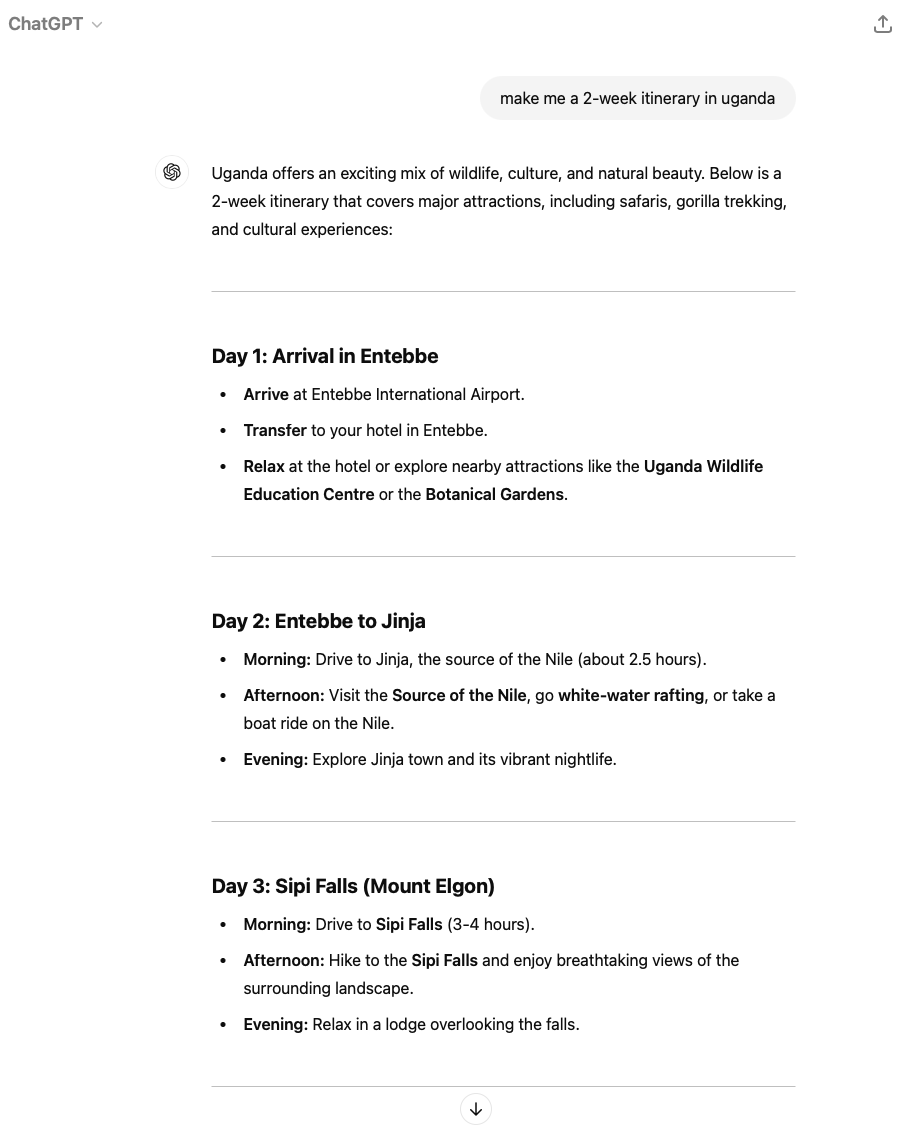
Source: Open AI, ChatGPT, 2024
Providing a seamless customer journey for maximum satisfaction
Digital processes that provide customers with seamless journeys from booking to delivery are in high demand. Understanding the customer journey can influence the success of a trip and customers’ satisfaction. The customer journey can start with them becoming aware of your product and finding out information on social media channels and websites to the ease of making bookings. Providing a seamless journey can help you generate positive customer reviews and retain customers.
Getting found online is a vital task for tour operators. One important way to get found is through Google Things to do. Google is constantly updating and improving this feature. You should feature your business on Google Things to do. Watch this YouTube video that explains how to use it or read Google’s Introducing Things to do on Google.
Customers increasingly prefer to book and pay online. Online bookings continue to increase and have become the new normal. Often, the ability the book online is a deciding factor for consumers. The use of mobile devices for all stages of research and booking is also increasing; two in five online bookings are now made on mobile devices.
Online booking provides consumers with an instant way of purchasing. Online travel agents (OTAs) have become the fastest growing sales channel for tours and experiences. It is estimated that the sector will grow by more than 150% by 2025 from pre-pandemic levels. They provide a huge source of tourism products that are easy to access and book. Trips can often be booked right up to the last minute, which suits younger consumers who like to act spontaneously. Platforms like GetYourGuide, Viator and WithLocals are examples of OTAs that specialise in trips, tours and experiences.
Looking ahead
AI and technological developments are here to stay, and business processes will evolve accordingly. Personalisation in accordance with customer preferences and interests will become the norm rather than merely ‘nice to have’. By analysing customer data, AI will become better at customising trips for customers. This provides opportunities for tour operators to become better at developing and targeting products.
Consumers will expect their holidays and trips to be seamless at all points of the customer journey. They will expect to be able to book and pay for their trips and experiences immediately. Online bookings will continue to grow until they become the predominant form of sales.
It is also important to bear the potential negative effects of AI in mind, particularly concerning privacy and the use of data. The EU and UK are looking to regulate the AI industry to ensure AI systems are safe, transparent, traceable, non-discriminatory and environmentally friendly. Read this article to find out more about the EU AI Act.
Tips:
- Do not ignore digitalising your business. If you do not embrace digitalisation or explore what AI can do for you, it will be difficult for you to grow in a competitive market.
- Explore GenAI tools to see what you can use to add value to your business. Some are free to use.
- Make sure you have a strong online presence. Manage your social media channels well and make sure they drive customers to your website. Download the CBI report How to be a successful tourism company online for tips.
- Add a chatbot to your website. They are easy to integrate. Ask your web developer to help you. Most online website builders offer this functionality. Use this step-by-step guide to help.
- Take bookings online, and ideally payment, through your website and/or social media page. If you list your tours with OTAs, their platform will manage this process for you. You should be prepared to work with OTAs. Use the CBI report How to work effectively with OTAs to help you.
4. Solo travel is a key trend
Solo travel is becoming more popular, and it is a major niche market today. Solo travellers go on trips by themselves, without friends or companions, although they may travel independently or in a small group. Solo female travel is undergoing particular growth. It is estimated that 84% of solo travellers are women. A 2024 study found that solo female travellers account for 14% of female tourism demand.
Solo travellers are a lucrative market as they are spending more on travel than in previous years. In 2022, 41% spent more than $2,000 (USD) per week on travel. In 2023, this rose to 53%. Almost one in ten solo travellers spent more than $4,000 per week. While Europe is the most popular destination for solo travellers, Central America and Southeast Asia are also popular.
Figure 5: Solo travellers’ spending on travel, 2022 to 2023
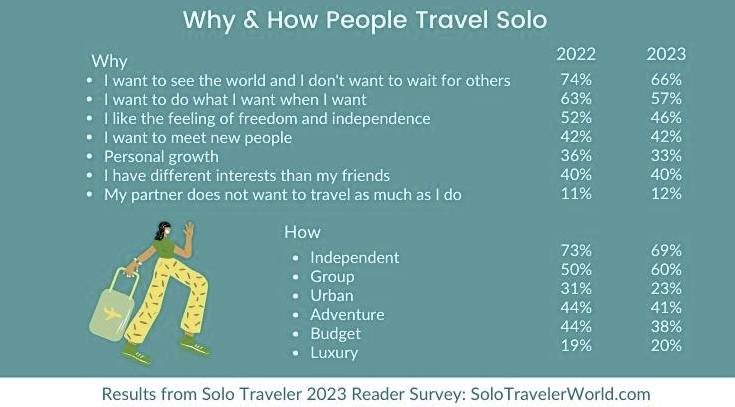
Source: Solo Traveller World, 2023
The older market aged 50+ is driving growth in the solo travel market. Life changes, such as divorce, death and simply being single and keen to travel, feed the interest in solo travel. Some solo travellers in this age group leave their partners at home, citing different travel interests. Health and wellness, cultural immersion and friendships are important to this group.
Growth in this market is also driven by digital nomads; people who work remotely when they travel. Many digital nomads travel alone (43.4%). It is believed there are more than 40 million digital nomads worldwide. Digital nomads are generally environmentally friendly and prefer to slow down and immerse themselves in the local culture rather than move to new places too frequently.
Looking ahead
Europe’s ageing population is made up of enthusiastic travellers who increasingly like to challenge themselves and stay active. In the coming years, there will be plenty of opportunities to attract this market, although businesses will need to be mindful of their needs as they age. See the section below, Embracing disability and the ageing market, for more information about this trend.
Digital nomads will be better supported by businesses as doubt surrounding the digital nomad lifestyle and productivity eases. As remote working technology continues to develop, becoming a digital nomad will become easier. More countries plan to issue digital nomad visas, and this target group is likely to stay longer in the destinations. South Africa, Peru, Sri Lanka and the Philippines plan to offer suitable visas at some point. The digital nomad family is another trend, in which the whole family travels with the working family member.
Tip:
- Find out more about the solo travel market in the CBI study What are the opportunities in the European solo tourism market.
5. Gen Y and Gen Z shaping the future of travel
The Gen Y and Gen Z consumer groups drive the changing face of the tourism industry. Future travel will be shaped by characteristics, motivations and needs specific to this group.
They are at different stages in their lives. Gen Y (also known as Millennials) are becoming more settled in their careers, and many have young families. Gen Z are starting out in the workplace and have more limited budgets for travel. However, both groups prioritise travel over things.
Both groups have grown up in a technology-driven world, and they are very tech-savvy. Social media channels, particularly Instagram, TikTok, YouTube and Facebook, are key platforms they use. Gen Y are more likely to follow small businesses and big brands, while Gen Z are heavy social media users. Both groups trust influencers more than brands.
To reach Gen Y and Gen Z, short videos that showcase exciting experiences are a great way to inspire them. They use TikTok, Instagram Reels and YouTube Shorts to discover and book experiences. Take a look at these examples of operators that make good use of TikTok and Instagram Reels.
As travellers, Gen Y and Gen Z want authentic, immersive experiences and adventures. They like to visit new places. They know a lot about sustainability, and they are very concerned with the health of the planet. They are very keen to minimise their impact on the environment and want to make positive contributions to destinations and communities.
Looking ahead
Gen Y and Gen Z will continue to influence the travel industry as they age. They will become the most important and valuable travel groups. Embedding sustainability into immersive and transformational experiences is a common expectation for this group. Understanding how they use technology throughout their journey and how they engage with brands is key to reaching this market successfully.
As digital natives, the fast rate of emerging travel technology will continue to affect how they engage with travel. They will also embrace new techniques and concepts enthusiastically. Local tour operators will need to keep up with the trends that will emerge in these groups over the next years.
Tips:
- Manage your social media channels appropriately for Gen Y and Gen Z. Instagram, TikTok and YouTube are the main channels for reaching Gen Y and Gen Z. Facebook is also used by Gen Y. Invest in content creation that is suitable for these markets, particularly videos. Use the CBI study How to be a successful tourism business online to help you.
- Invest in an influencer marketing campaign to attract both markets. Gen Y and Gen Z trust ‘word of mouth’ marketing more than traditional marketing techniques. Find out more in the CBI study How to work with influencers.
- Find out more about the Gen Y and Gen Z markets in the CBI studies What are the opportunities on the European Gen Y tourism market and What are the opportunities in the European market for Gen Z tourism.
6. Embracing accessibility and the ageing market
The market for accessibility is very large. It is comprised of people with disabilities, elderly people with access needs and other groups with specific needs. In Europe, the market is substantial as the continent has an ageing population. In the EU in 2023, more than one fifth of the population (21.3%) was 65+, and 155 million people are expected to be over 65 by 2040.
In Europe and the UK, disabled people are legally protected and have the right to access air, train, bus, coach and boat travel. They also have the right to be treated with respect, to independence and not to be discriminated against. They are considered to have the same rights as people without disabilities.
As barriers to travel have lessened somewhat for Europeans with disabilities, the demand for exciting travel experiences is strong. In 2018 and 2019, more than 27 million tourists with disabilities took 81 million trips, spending $58.7 (USD) billion on their travel alone. This figure is likely to be much higher as people with disabilities often travel with other people.
People with neurodivergent needs (defined as mental or neurological needs that are different from what is considered typical or normal, like autism) need a more inclusive approach to travel. It is expected that AI will help deliver tools to support this market. Benefits could include real-time updates and sensory-friendly environments, like noise-cancelling facilities in airports and hotels.
Retiring from work can be a boost to travel by the ageing population. European tourists aged 65+ accounted for almost one quarter of tourism nights (23%) in 2022. However, as they are cash and time rich, they often take longer trips. They can also extend the peak tourism season as they are more likely to travel during shoulder and low seasons. The chart below shows how individuals aged 65+ make longer trips and have a longer average length of stay.
Figure 6: Travel preferences of EU residents by age
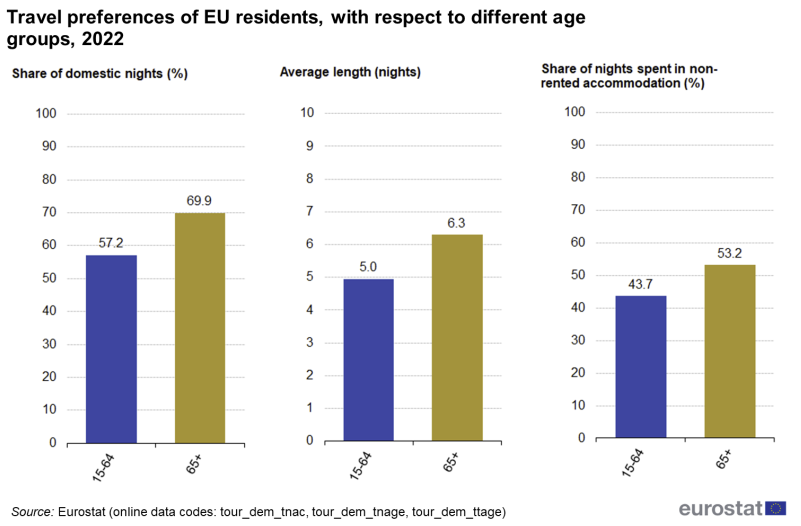
Source: Eurostat, 2022
Many ageing people are Baby Boomers (born between 1946 and 1964, aged 60 and 78 in 2024). Baby Boomers are a highly discerning group of tourists who like to travel, despite increased needs. They are still the wealthiest group of travellers globally and prepared to pay for extraordinary experiences. In line with transformational travel trend, they seek active, authentic and luxury travel experiences.
One of the key requirements for this market is to listen to what they need and be honest about what you can and cannot provide. It is essential not to over-promise to make a sale. It will harm your reputation and may cause your client distress. It is a good idea to appoint a dedicated staff member to look after your clients with disabilities who is a good listener, proactive and able to get things done.
Looking ahead
The market is forecast to grow on account of Europe’s ageing population. In addition, the market is becoming more demanding of its right to travel and have access to the same experiences as everyone else. As more Europeans with disabilities and advanced age-related needs demand interesting and immersive travel experiences, local tour operators can take advantage of this trend by supplying them.
Competition is still quite limited in this market. Only a few specialist tour operators serve the market. As a result, there are good opportunities for local tour operators to provide quality experiences with high standards of care. Personalisation is very important in this sector: all clients must be treated individually and with respect.
Tips:
- Assess your current trips and experiences. Look at what you can change to be more accessible. There are a range of low-cost, practical solutions that you can put in place to make your tours accessible. Find out more in the CBI study What are the opportunities in the European market for accessible tourism.
- Appoint someone in your team to take charge of accessibility. This will impress your buyers who will see that you take their needs seriously.
- You can find out more about targeting this market in the CBI study What are the opportunities on the European baby boomer tourism market.
7. Trend for more robust safety and security measures
Personal security, perception of the safety of a destination, and health and hygiene concerns are all factors that affect tourists’ choice in holiday decisions. The COVID-19 pandemic, the war in Ukraine, the conflict in the Middle East and other political tensions around the world have all contributed to a heightened sense of concern for the travelling public in recent years. While excited to travel, tourists are now more careful about the choice of destination so they can be sure they will be safe.
Contactless systems have helped to transform the tourism industry. They are convenient, hygienic and improve security. Contactless payment reduces the need to handle cash or touch payment machines. This reduces the chance of passing on diseases. Mobile check-in and check-out at hotels and smart key cards speed up processes for visitors while addressing health concerns.
Facial recognition at airports has also improved security. QR codes in restaurants that visitors use to order are also becoming more common. The convenience of contactless systems has become a ‘must-have’ for many consumer groups.
Tour operators can play an important role in reassuring guests by being open and transparent about the risks at their destinations. The Travel Risk Map is a good tool to find out where your destination sits in terms of medical and security risks. Making a page on your website to reassure visitors of measures in place to keep them safe is a good idea. Be sure to include all the measures you take to reduce the likelihood of contracting illnesses, like having hand sanitisers and masks readily available.
Looking ahead
Today, the need for robust safety and security measures are now the new normal. This will continue well into the future. Contactless solutions will continue to evolve to be ever more efficient, convenient and safe.
Tips:
- Understand what all the risk factors are in your destination, including safety, security and medical risks. If you do not have one, put together a Risk Management policy. The CBI study How to manage risks in tourism can help you with this.
- Make sure you have a page on your website that clearly states your safety and security measures. Be very clear about what you do to keep people safe. You will gain trust this way.
- Request that your guests have travel insurance, even if you have your own policy. This will not protect you, but tourists are more likely to make claims using their own insurance. If you do not have business liability insurance, you need it. Download the CBI study What are the requirements for tourism services in the European market.
Acorn Tourism Consulting Limited carried out this study on behalf of CBI.
Please review our market information disclaimer.
Search
Enter search terms to find market research

